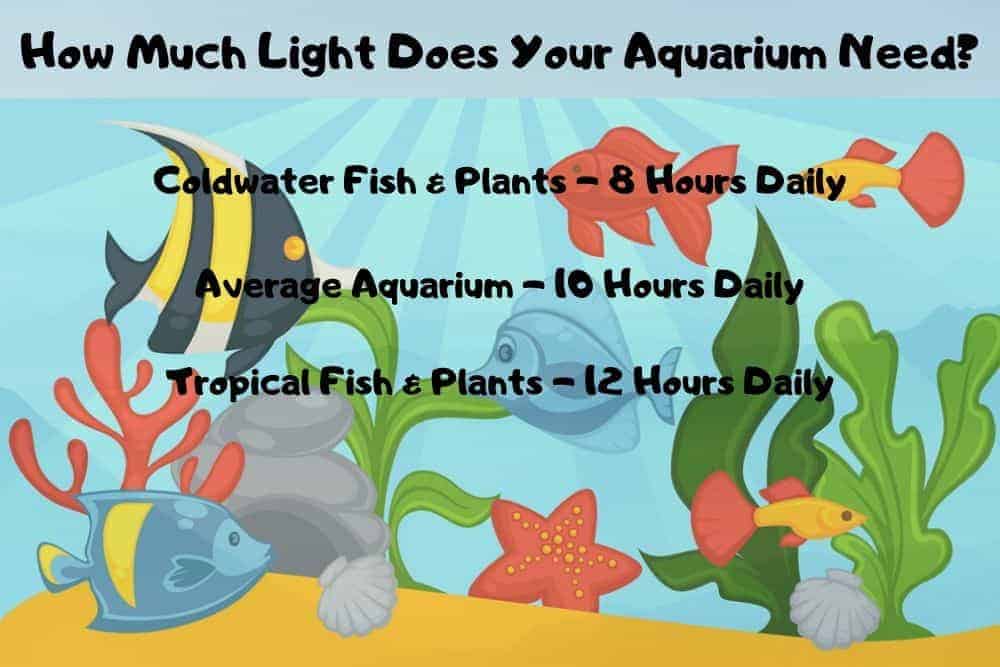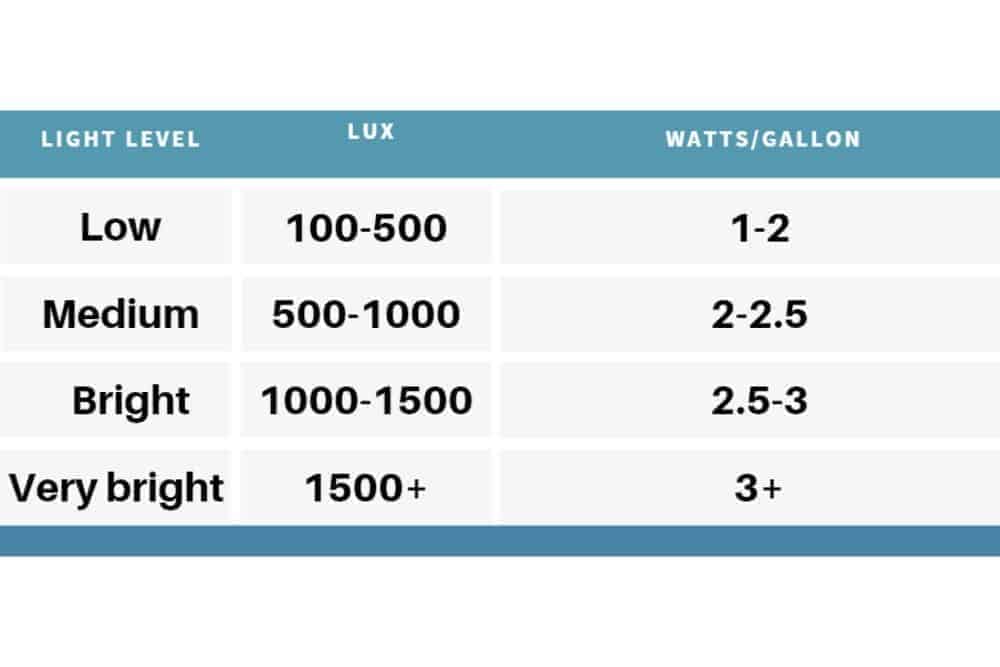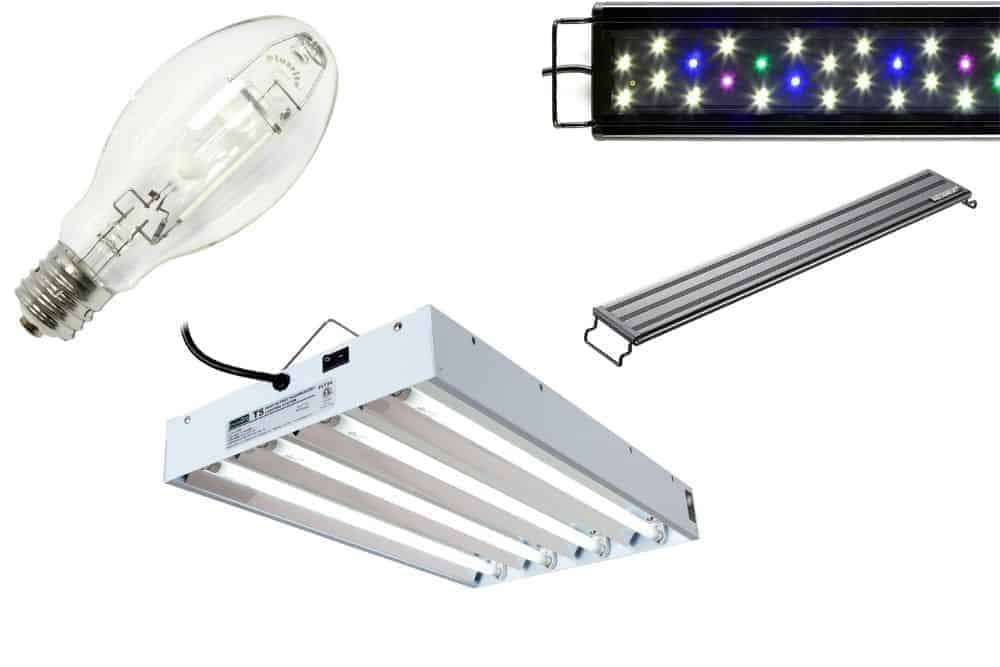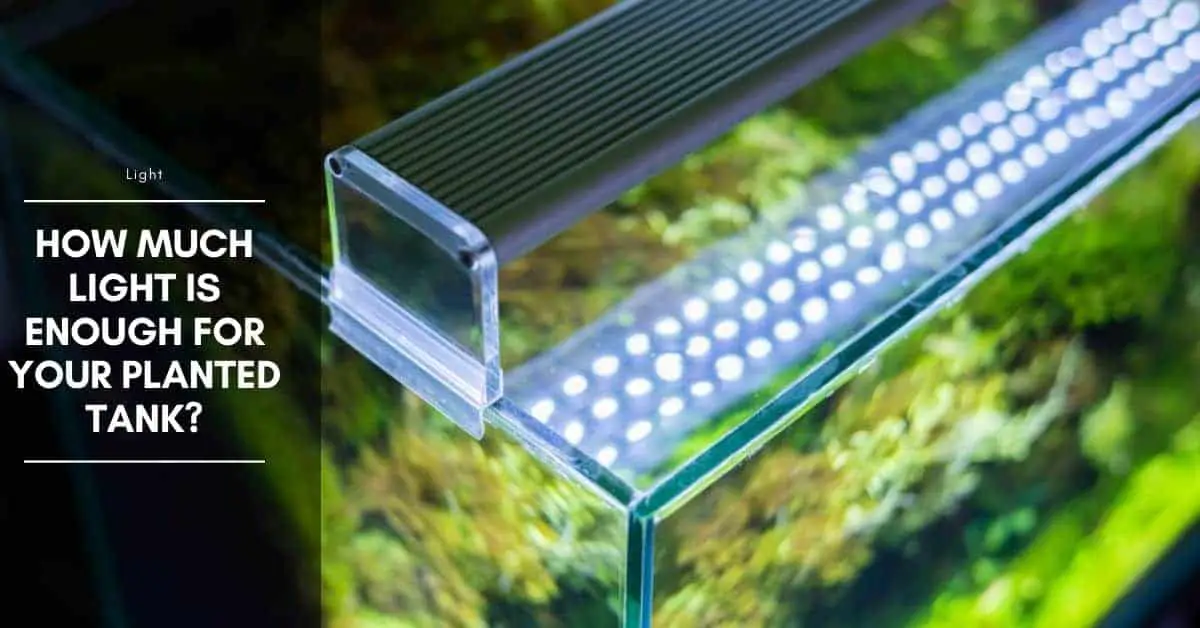Light is a fundamental issue in the planted aquarium. Is there enough? Is there too much? Is it the right kind? Is it reaching the plants at the bottom?
And there are so many different lighting options available that it is easy to be confused. Try not to be blinded by the choices. A bright light from practically any source will promote plant growth.
Some people even use sunlight. I know that’s a radical concept, but aquatic plants grow extraordinarily well in vases on windowsills where the evaporated water is replaced with water being changed out of a fertile aquarium.
There is a number of ways to light an aquarium

Certainly, the aquarium lighting vendors present an impressive array of options, each with its specific application. Besides the standard aquarium hood-type lighting units, creative aquarists use the light that gets the job done for the plants they are keeping.
There’s nothing wrong with using an 8-watt desk light to spotlight a gallon-sized planted nano tank, or a combination of room light and pendant lights to highlight sections of the aquarium.
That said, the standard “starter kit” aquarium light with incandescent bulb or bulbs is far from an optimal choice for the aquarist seeking success with aquarium plants. Incandescent bulbs are inefficient and create excessive heat that can be problematic, especially in the summer months.
Various type of light for planted aquarium
Lighting for the planted tank is typically achieved through the use of multiple units of standard fluorescent, T5 HO (high output), VHO (very high output), compact fluorescent/power compact (PC), LED and metal halide/HQI lights.
Aquarium lights are available in a large selection of spectrums and intensities, and also in compact sizes. T5 HO fluorescent and power compacts produce high light output in small spaces. T8 is most often used by hobbyists and offers the most options. Power compact T5, high-output T5, and metal halides are used for aquaria that need the brightest light. Bright lights suspended in luminaires over an open tank seem to offer the best of all worlds.
Light Intensity
Unfortunately, the light produced by your unit is not necessarily the light that reaches the plants. The amount of light reaching the plants is reduced by several factors: reflection, shade, and absorption.
A certain percentage of the light is reflected off the surface of the water, another part is absorbed by the light cover and minute suspended particles in the water, and still, more light is lost to the bottom of the aquarium by the leaves of the plants in the upper level of the tank.
With this in mind, we will make sure that we eliminate factors that might further reduce the light reaching the bottom: by cleaning the light covers regularly, keeping an eye on the density of plants at the surface, and making sure the water is kept clear of suspended particulate matter by good mechanical filtration.
API STRESS COAT Aquarium Water Conditioner 16-Ounce Bottle
Tetra AquaSafe Plus, 8.45 Ounces, aquarium Water Conditioner And Dechlorinator, Model Number: 46798162681
$10.19 (as of December 28, 2025 14:59 GMT +03:00 - More infoProduct prices and availability are accurate as of the date/time indicated and are subject to change. Any price and availability information displayed on [relevant Amazon Site(s), as applicable] at the time of purchase will apply to the purchase of this product.)API TAP WATER CONDITIONER Aquarium Water Conditioner 16-Ounce Bottle
$8.48 (as of December 28, 2025 14:59 GMT +03:00 - More infoProduct prices and availability are accurate as of the date/time indicated and are subject to change. Any price and availability information displayed on [relevant Amazon Site(s), as applicable] at the time of purchase will apply to the purchase of this product.)Light penetration is usually not a major problem in the relatively shallow home aquarium, but light intensity becomes markedly reduced at depths of over 3 feet. Also, it is often the nature of the smaller plants that hug the substrate to require less intense light than others because they would likely also be shaded by bigger plants in their native environments. Most aquarists measure their lighting intensity in watts per gallon.
Simply add up the total wattage of the bulbs over the tank and divide by the number of gallons. For planted tanks, 2 to 3 watts per gallon is generally adequate. With very deep tanks and plants that require bright light, as much as 4 or 5 watts per gallon could be necessary. Lux represents the amount of light provided. The table below gives light levels in terms of lux and watts to achieve different lighting levels.

The lighting levels recommended for the plant species – bright, medium, or low are best for those species. But plants live in a range of conditions, so a plant that prefers low light could be very stable in a bright aquarium with 3 to 5 watts reaching the gravel if it was shaded by a piece of driftwood or lived in the shadow of a larger plant.
Use bright light unless you are specifically designing a lowlight aquascape. Many of the nicest foreground plants need bright light, so if you like the look of a grassy plain across the front glass of the tank, use wattages that will penetrate the depth.
A lamp produces light of certain colors or wavelengths. Each type of lamp, depending upon the material from which it is constructed, will emit red, yellow, green, and blue in different intensities.
For photosynthetic purposes, plants favor the warm red and orange over the yellow and green and pick up power again on the blue-green end of the spectrum. Both blue-green and orange-red wavelengths are necessary for healthy plants.
The color spectrum of light is noted as a “Kelvin rating.” Natural sunlight gives a reading of 6,500 K. Most plant enthusiasts look for bulbs in the 5,000 K to 10,000 K range. Full-spectrum lighting in the area of 6,500 K is ideal for plant growth and viewing pleasure.
There are special plant bulbs that produce light in the red and blue areas of the color spectrum, which focuses on the colors of light that plants use most, and these are also excellent. Avoid the use of “cool white” utility bulbs or ultra-blue “reef aquarium” tubes used by marine aquarists, which may have ratings as high as 20,000 K.
Generally, light green plants require the brightest light; dark green plants accept lower light, and red-hued plants reflect red light and use light from the blue end of the spectrum.
Lighting Options
Fluorescent lights provide great value for the money spent.
They are cool-running and will not overheat the water. Many aquarists report good results with “full-spectrum,” “daylight,” and specialty “aquarium plant” lights—available from every aquarium shop, garden center, and good hardware store that caters to gardeners.
High color-performance fluorescent tubes will give you the color and intensity of light you need. Usually, about 2 watts per gallon is sufficient, but if CO2 is added to the water, the light intensity needs to be adjusted upward to correspond to increased plant growth.

Keep in mind that fluorescent bulbs age, shift spectrum, and lose intensity over time. Fluorescent bulbs should be changed every 6 to 12 months (try to have the bulbs on a rotating schedule; i.e., a new bulb every 6 months rather than two new bulbs every year).
Metal halide fixtures and high-output and power compact lighting. Most aquarists use fluorescent lighting, but the good light work that has been done on the marine side of the hobby has made many high-quality metal halide fixtures and high-output and power compact lighting available.
These are most important to people who have large, deep tanks and are prepared to invest in higher-tech equipment. When the planted aquarium is high art, and the goal is maximum growth in the short term—perhaps for the length of time it takes to ready for a competition or to get one perfect photo—there are many high-quality systems and much detailed information available via the planted aquarium societies and clubs.
Sunlight
Natural sunlight would be great for the plants in the aquarium if we could count on it. The changing seasons have a lot to do with how much sunlight the aquarium will receive, though, and the tank that gets good light in the spring might well turn into an algae-ridden hot tub in the middle of the summer.
If you are going to supplement your artificial lighting with the free light that streams through your windows, be sure you plan your location carefully. The best arrangement would be to place the tank a few feet from a window in an area that receives morning light.
Be sure you can “turn off the light” with a curtain or shade if the water has a tendency to overheat or if you find that algae is taking over.
Lighting Duration
Tropical plants require 12 hours of light a day, every day.
However, you can’t make up for low-intensity light or light of the wrong spectrum by increasing the duration of the lighting. The duration of light is much more important than most people realize.
Even if the lighting intensity is adequate, the plants cannot produce enough energy to live if the lights are not left on long enough. Twelve hours each day is ideal; less than 10 or more than 14 is not advised.
Because the duration of light is so important to aquatic plants, one of the most inexpensive but useful accessories you can ever buy for your aquarium is a timer for the lights. Day-in and day-out predictability of photoperiod is important to both plants and fishes.

Hi, my name is Sean, and I’m the primary writer on the site. I’m blogging mostly about freshwater and saltwater aquariums, fish, invertebrates, and plants. I’m experienced in the fishkeeping hobby for many years. Over the years I have kept many tanks, and have recently begun getting more serious in wanting to become a professional aquarist. All my knowledge comes from experience and reading forums and a lot of informative sites. In pursuit of becoming a professional, I also want to inspire as many people as I can to pick up this hobby and keep the public interest growing.
Read more about Sean.
Please join also my Facebook group.




















